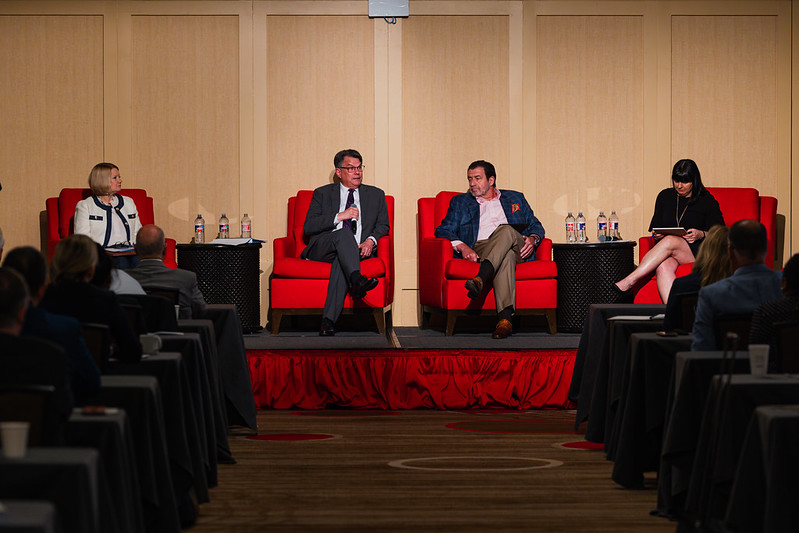On May 30, energy leaders, policymakers, and innovators gathered at the Hilton Hotel on the University of Houston campus for the 2025 edition of Energy Transition Winds of Change: Technology and Policy Implications in the New Market. Hosted by UH Energy and the Center for Carbon Management in Energy (CCME), the event spotlighted how accelerating alignment between policy, innovation, and investment is shaping a more accessible, sustainable, and reliable energy future.
Opening the event, Chuck McConnell, Executive Director of CCME, framed the energy transition as a pivotal moment in the global energy landscape. He emphasized the United States’ critical role in leading this transformation, underscoring the importance of strategic alignment across sectors and the adoption of next-generation technologies.
U.S. Policy and Real-World Deployment
The day’s first panel focused on how domestic policy is influencing the pace and direction of sustainable energy infrastructure in the United States. Moderated by Kerry McGrath, Partner at Hunton, the panel featured:
- Gregg Russell, SVP of Carbon & Sustainable Ventures, DTE Energy
- Susan Margaret Floyd, VP of Enterprise Environmental Services, Entergy Services
- Karl Moor, CEO, Powerscape Global
Panelists addressed a range of challenges, from regulatory uncertainty and lengthy permitting timelines to the role of corporate partnerships in reducing risk for early-stage projects. A recurring theme was the need for consistent federal signals paired with localized, flexible implementation strategies.
Karl Moor emphasized the urgency of rethinking the U.S. coal narrative. Rather than abandoning coal, he advocated for leveraging it through innovative technologies like gasification and methods to turn natural gas into syngas to produce essential chemicals such as ammonia, transforming a widely available but underutilized resource into a value-added product. He passionately stressed that reviving coal, both domestically and abroad, could present a real and achievable solution for global energy insecurity.
The panel agreed that financial incentives like Section 45Q, the federal tax credit for carbon storage, along with streamlined Class VI permitting under the new administration, are crucial to making CCUS projects economically viable. They emphasized that smart capital, sound policy, and strong science and engineering are essential to securing U.S. leadership in carbon management innovation.
A Global Outlook: Risk, Opportunity, and the Energy Marketplace
Shifting from domestic policy to global dynamics, the second panel explored the evolving energy marketplace and the role of private-sector investment, technology, and infrastructure. Moderated by Steve Everley, Senior Managing Director at FTI Consulting, the panel included:
- Jameson White, Director of Membership & Committees, EnerGeo Alliance
- Gardner Boulmay, Chief Commercial Officer, Fidelis New Energy
- Pete Sheffield, VP of External Affairs & Chief Sustainability Officer, Enbridge
Against geopolitical shifts since the Paris Climate Agreement, the panel discussed how the global energy conversation has shifted, moving beyond a primary focus on decarbonization efforts to prioritize energy accessibility, reliability, and resilience, while still advancing CCUS technology implementation.
Gardner Boulmay underscored the immense energy requirements on the horizon:
“We need as much power as possible, and even more than we can fathom for the future.”
Pete Sheffield emphasized that the energy transition should be viewed as an “energy addition,” not a replacement. The panelists stressed the importance of maintaining a clear-eyed understanding of energy fundamentals, especially as developing regions demand more power and industrialized nations electrify at scale.
Meeting the Demand Surge: AI, Infrastructure & Innovation
Surging power demand from AI, robotics, and data centers emerged as another key concern. Panelists noted that the U.S. power grid is struggling to keep pace, with regulatory delays and fragmented systems creating persistent bottlenecks. Boulmay called for significant infrastructure investment to address these challenges.
The panel stressed the need for constructive, forward-looking regulation to accelerate energy deployment. White noted that global energy production must increase by 34% by 2050 to meet demand—reinforcing the necessity of continued oil and gas exploration alongside renewables and emerging technologies.
Emissions Over Fuel Type: A Practical Approach
When asked about the future of CCUS, panelists agreed that technological readiness must be matched by strong regulatory frameworks. They emphasized the need to move the conversation away from fuel types and instead focus on how emissions are managed.
The panel pointed to the projected 34% increase in energy demand by 2050 and emphasized that embracing both traditional and alternative energy sources will be critical to ensuring global energy stability, equity, and sustainability.
Everley concluded the discussion by steering it toward long-term strategy. Panelists agreed that universal access to energy must be treated as a global imperative, and that policy must keep pace with the scale and speed of technological advancement.
Panel One: Current Energy Transition Policy and Project Updates
